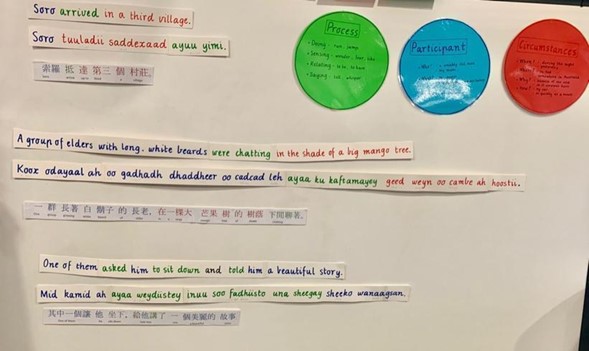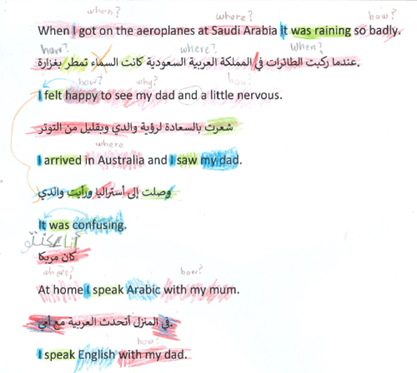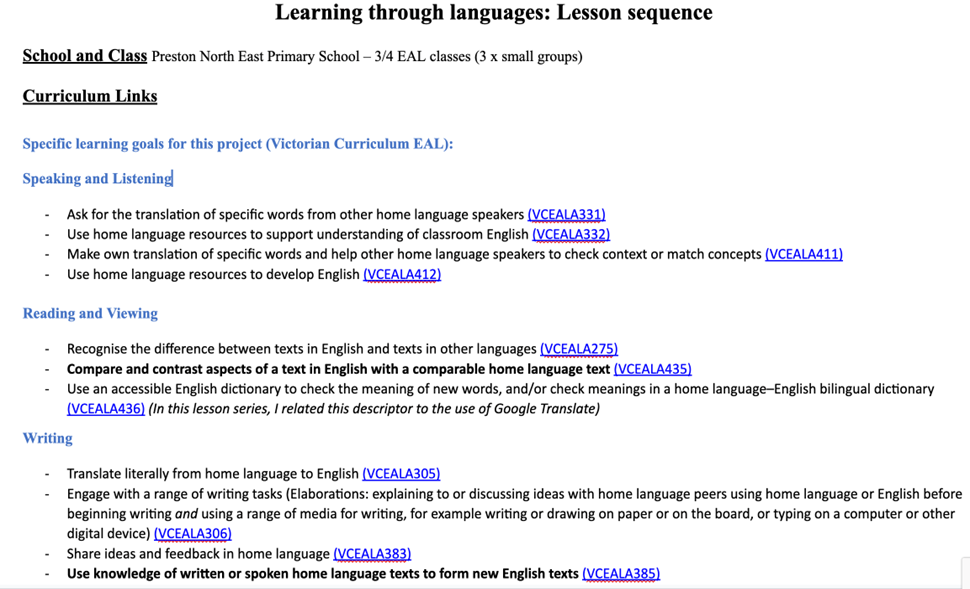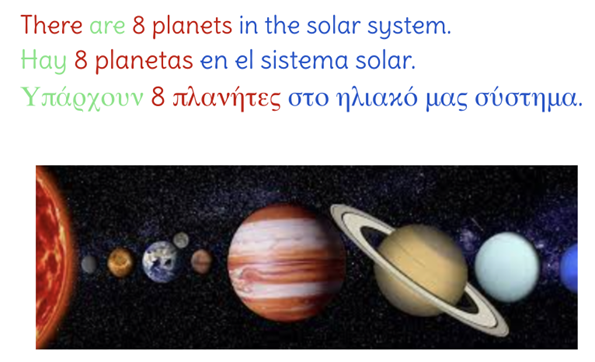Actively working with students' languages demonstrates a commitment to who students are and what they know. Without official affirmation, it is easy for students to undervalue heritage languages and gradually make a transition to monolingualism.
The objective is not to teach home languages in class. It is a valuable, additional benefit that students learn more about their home languages. The objective is still to teach English and other content areas at school.
All students can benefit from having other languages in the classroom. This is true even if students' English language proficiency is high. It can be easier to see how a language such as English is structured if it is put side by side with other languages. It is also important that students have a rich understanding of the linguistic and cultural diversity in Australia.
A willingness to explore language with students and discover similarities and differences together is key. No specialist knowledge is needed to get started.
Teachers discuss working with languages
Stories from the classroom
Comparing and contrasting language
Teacher: Michelle Andrews, Preston North East Primary School
Class type: EAL students, withdrawal class
Ages: 9 to 11 years old
Languages: Tagalog, Somali, Mandarin, Telugu, Malayalam, Arabic, Vietnamese
EAL curriculum levels: B1 to B3
Michelle decided to focus on comparing and contrasting languages in her classroom. She used some bilingual texts to ensure that students understood this new strategy. Michelle found simple sentences in the texts and used Google Translate to check her understanding. Michelle then used these sentences in a noticing activity with the students.
"We started off by looking at bilingual texts and I took a simple sentence from those bilingual texts and translated it on Google Translate and worked out – I had to find a sentence that I could work out what the different bits were.
We looked at the different parts of the sentence, for example, which are the words in the sentence that tell us where this is happening, and then found the same part of the sentence in the other language. We had a look at where those were, and sometimes it was in the same place. Sometimes the different parts of the sentence were in the same order, but sometimes it was mixed up and so we noticed any difference in the order of the language.
Then I asked the students, 'What's it like in your language?' They had to have a think and they said, 'No, it's the same as English,' or, 'It's the same as that language, we put that bit first.' Or sometimes they said, 'It's not the same as either of them, we would say it last.' That was how we started to get them to compare how different languages work and to build that understanding that they don't all work the same."
Michelle then used colour-coding to draw attention to similarities and differences between languages. Process words (doing, sensing, relating, saying) were coloured green, participant words (the 'who' and the 'what') were coloured blue, and circumstance words (the 'where', 'when', 'why', 'how') were coloured red.
Comparing/contrasting using process, participant, circumstance

Michelle also wrote the sentences in English and the other languages on sentence strips and cut each into participant, process and circumstance to discuss with the students. Seeing the languages side by side like this highlighted similarities and differences.
Student's work sample

One of the biggest benefits Michelle noted from these activities was the way home languages were normalised in the classroom. Her students felt much more comfortable using their home languages openly as a resource for their learning. Students also enjoyed learning about the home languages of their classmates.
Student reflections
"I was interested, because we say “birthday person” in English, but in Vietnamese it’s the other way around. Like “person birthday”. I figured out in Malayalam we say “birthday person” just like English.
Sometimes Telugu uses two words when English uses one. In Telugu, the order is different. In English we say, “I went to a party”, but in Telugu we say, “I party went to”.
Sometimes if you have one word in English, you need lots of words in Arabic. “And” in Arabic is only one letter. In Arabic you start writing from the right to the left."
Michelle was also able to ask education support staff to come and help write different languages underneath a text written in English on the whiteboard (see Getting support from the school community section). The education support staff were very excited to be a part of this initiative, and Michelle was planning to ask parents in the future.
Learning through languages: Lesson sequence

Supporting resources
Using Google Translate
Teacher: Michelle Andrews, Preston North East Primary School
Program: EAL students
Class type: Withdrawal class
Ages: 9 to 11 years old
Languages: Tagalog, Somali, Mandarin, Telugu, Malayalam, Arabic, Vietnamese
EAL curriculum levels: B1 to B3
Michelle found that Google Translate was a very useful tool while working with languages in the classroom. She used Google Translate as a way to introduce activities (see the Comparing and contrasting language section). She started with the other language and translated into English. If the language did not sound authentic, she wrote it in a more natural way.
Google Translate was also very useful for the students who were not confident reading and writing in their home language. The sound function was particularly useful for these students.
"Most students did not have high literacy skills in their home language, so the sound function in Google Translate helped a lot. Students could listen to the translation to see if it was correct, then if needed we could try to adjust the English to change the translation a bit. This in itself was interesting as it gave a bit of an insight into how the language worked."
Michelle noted that students who did not have high literacy skills in their home language needed to be supported. She thought it was a valuable learning experience and also that it was helping them to be more knowledgeable about their home language.
"Some of the students wanted to include speech bubbles in their pictures, even if they couldn't write in their home language, so we used Google Translate and they copied meticulously! This interest in and enthusiasm to have a go at writing their home language was a real bonus!"
She also noted that interesting negotiations occurred between pairs of students who shared a home language but had different degrees of literacy. Once the students who could not read the script knew where everything was in a sentence, they participated enthusiastically in the activities (see the Comparing and contrasting language section for example activities).
The teacher’s language knowledge
Teacher: Antonia Ioannou, Collingwood English Language School
Class type: EAL students
Ages: 11 to 13 years old
Languages: Assyrian, Arabic, Vietnamese, Tamil
EAL curriculum levels: BL.1 to B2.2
Teachers' background knowledge can also be used to good effect when working with languages. Teachers do not need to consider themselves to be fluent in a language to use what they know in comparing and contrasting activities.
Antonia had planned to teach a sequence of lessons about the planets and decided to integrate language noticing activities into this sequence. She used colour-coding to show where the process, participants and circumstance were in different languages (see the comparing and contrasting section below).
Comparing/contrasting languages using colour-coding

Antonia used her knowledge of Greek and Spanish in this activity. She has a Greek heritage and she has learned Spanish as a foreign language.
"I put Greek into Google Translate first to get the script because otherwise my computer doesn't have the script, but I noticed that, because I know Greek, I had to make some changes. And looking at how Google Translate directly translated into Greek was interesting because it's not always correct. Even just translating that text I learnt a lot about Greek and how we use a lot more descriptive words."
Google Translate often makes direct translations that are not always correct. In this way, it can be used as a springboard to generate greater understanding about different languages, including English.
Another advantage of Google Translate is the use of different scripts. These scripts can be copied and pasted by teachers and students who don't have them on their computer.